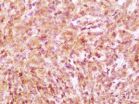(Press-News.org) CINCINNATI—It's not the size of the stomach that causes weight loss after a specific type of bariatric surgery, but rather a change in the gut metabolism, say researchers from the University of Cincinnati (UC), the University of Gothenburg in Sweden and Cincinnati Children's Hospital Medical Center.
The scientists, publishing their results in the March 26, 2014, advanced online edition of Nature, have found that following vertical sleeve gastrectomy, there is a change in bile acids that bind to a nuclear receptor called FXR. In the absence of FXR, the researchers showed, weight-loss success and improvement in diabetes from vertical sleeve gastrectomy is reduced.
Vertical sleeve gastrectomy, VSG, is a bariatric procedure in which approximately 80 percent of the stomach is removed to create a gastric "sleeve," which imposes a physical restriction on the amount of food that can be consumed at one time.
"There are very large debates over how small to make the sleeve," says co-principal investigator Randy Seeley, PhD, professor in the endocrinology, diabetes and metabolism division at UC and director of the Cincinnati Diabetes and Obesity Center. "Conventional thought is when you make the stomach smaller, patients lose more weight because they have less room to put more food and, therefore, eat fewer calories. But as it turns out, the reason why the surgery works is that you are changing the bile acids."
This study, Seeley says, is the first empirical evidence that the therapeutic value of VSG is not a result of the mechanical restriction of a smaller stomach, but the result of increased circulating bile acids that are known to bind to the nuclear receptor FXR.
That discovery, he says, was made in a mouse model by removing the FXR receptor in obese mice that had undergone VSG. Despite having a smaller pouch, or "sleeve," Seeley says, rodents without the FXR receptor didn't lose weight.
Because bile acids and FXR receptors interact with gut microbial communities, the researchers also looked at gut bacteria after VSG. They found that the surgery also results in changes in the gut bacteria.
"Importantly, we observed changes in several key bacterial groups that have been previously linked to the risk of Type 2 diabetes, and these changes were related to FXR and bile acids," says Karen Ryan, PhD, lead author and assistant professor of endocrinology, diabetes and metabolism at UC.
"Manipulating the gut bacteria is another way we think that we might be able to mimic how surgery works without having to do the cutting and stapling," Seeley says.
The significance of this study is in the exploration of future treatments for obesity and Type 2 diabetes, as bariatric surgery is proven to provide substantial improvements in obesity and obesity-related conditions.
"There are not enough surgery tables or surgeons to treat the obesity epidemic, so we need to understand how bariatric surgery works so that we can offer more scalable solutions," Seeley says.
INFORMATION:
This work was supported by grants from the UNIK Food Fitness and Pharma for Health and Disease research programme, the Torsten Söderberg and Novo Nordisk foundations, Ethicon Endo-Surgery, and the National Institute of Health's National Institute of Diabetes and Digestive and Kidney Diseases and National Heart, Lung and Blood Institute.
Seeley has received research support from Ethicon Surgical Care and Novo Nordisk, and has served as a consultant or paid speaker for Ethicon Surgical Care.
Gut metabolism changes -- not stomach size -- linked to success of vertical sleeve gastrectomy
2014-03-26
ELSE PRESS RELEASES FROM THIS DATE:
Some breast cancer tumors hijack patient epigenetic machinery to evade drug therapy
2014-03-26
PITTSBURGH, March 26, 2014 – A breast cancer therapy that blocks estrogen synthesis to activate cancer-killing genes sometimes loses its effectiveness because the cancer takes over epigenetic mechanisms, including permanent DNA modifications in the patient's tumor, once again allowing tumor growth, according to an international team headed by the University of Pittsburgh Cancer Institute (UPCI).
The finding warrants research into adding drugs that could prevent the cancer from hijacking patients' repressive gene regulatory machinery, which might allow the original therapy ...
First comprehensive atlas of human gene activity released
2014-03-26
Boston, MA — A large international consortium of researchers has produced the first comprehensive, detailed map of the way genes work across the major cells and tissues of the human body. The findings describe the complex networks that govern gene activity, and the new information could play a crucial role in identifying the genes involved with disease.
"Now, for the first time, we are able to pinpoint the regions of the genome that can be active in a disease and in normal activity, whether it's in a brain cell, the skin, in blood stem cells or in hair follicles," said ...
Brain degeneration in Huntington's disease caused by amino acid deficiency
2014-03-26
Working with genetically engineered mice, Johns Hopkins neuroscientists report they have identified what they believe is the cause of the vast disintegration of a part of the brain called the corpus striatum in rodents and people with Huntington's disease: loss of the ability to make the amino acid cysteine. They also found that disease progression slowed in mice that were fed a diet rich in cysteine, which is found in foods such as wheat germ and whey protein.
Their results suggest further investigation into cysteine supplementation as a candidate therapeutic in people ...
Cosmic collision creates mini-planet with rings
2014-03-26
Until now, rings of material in a disc have only been observed around giant planets like Jupiter, Uranus, Neptune and especially Saturn, which is known for its spectacular rings. Now astronomers from the Niels Bohr Institute, among others, have observed the first miniature planet with two rings of ice and pebbles. It is a smaller celestial body, called Chariklo, located two billion kilometers out in the solar system between Saturn and Uranus. The results are published in the prestigious scientific journal, Nature.
Chariklo was located in the Kuiper Belt, a collection ...
New maps for navigating the genome unveiled by scientists
2014-03-26
Scientists have built the clearest picture yet of how our genetic material is regulated in order to make the human body work.
They have mapped how a network of switches, built into our DNA, controls where and when our genes are turned on and off.
University of Edinburgh scientists played a leading role in the international project – called FANTOM5 – which has been examining how our genome holds the code for creating the fantastic diversity of cell types that make up a human.
The three year project, steered by the RIKEN Center for Life Science Technologies in Japan, ...
Keeping secrets in a world of spies and mistrust
2014-03-26
VIDEO:
This is an interview with Professor Artur Ekert, co-inventor of quantum cryptography, about what it takes to keep secrets secret.
Click here for more information.
Revelations of the extent of government surveillance have thrown a spotlight on the security – or lack thereof – of our digital communications. Even today's encrypted data is vulnerable to technological progress. What privacy is ultimately possible? In the 27 March issue of Nature, the weekly international ...
Cell-saving drugs could reduce brain damage after stroke
2014-03-26
Long-term brain damage caused by stroke could be reduced by saving cells called pericytes that control blood flow in capillaries, reports a new study led by scientists from UCL (University College London).
Until now, many scientists believed that blood flow within the brain was solely controlled by changes in the diameter of arterioles, blood vessels that branch out from arteries into smaller capillaries. The latest research reveals that the brain's blood supply is in fact chiefly controlled by the narrowing or widening of capillaries as pericytes tighten or loosen around ...
Should whole-genome sequencing become part of newborn screening?
2014-03-26
That question is likely to stir debate in coming years in many of the more-than-60 countries that provide newborn screening, as whole-genome sequencing (WGS) becomes increasingly affordable and reliable. Newborn screening programs – which involve drawing a few drops of blood from a newborn's heel – have been in place since the late 1960s, and are credited with having saved thousands of lives by identifying certain genetic, endocrine or metabolic disorders that can be treated effectively when caught early enough. Advocates of routine WGS for newborns argue that the new technology ...
Solar System's edge redefined
2014-03-26
Washington, D.C.—The Solar System has a new most-distant member, bringing its outer frontier into focus.
New work from Carnegie's Scott Sheppard and Chadwick Trujillo of the Gemini Observatory reports the discovery of a distant dwarf planet, called 2012 VP113, which was found beyond the known edge of the Solar System. This is likely one of thousands of distant objects that are thought to form the so-called inner Oort cloud. What's more, their work indicates the potential presence of an enormous planet, perhaps up to 10 times the size of Earth, not yet seen, but possibly ...
Penn Dental Medicine-NIH team reverses bone loss in immune disorder
2014-03-26
Patients with leukocyte adhesion deficiency, or LAD, suffer from frequent bacterial infections, including the severe gum disease known as periodontitis. These patients often lose their teeth early in life.
New research by University of Pennsylvania School of Dental Medicine researchers, teaming with investigators from the National Institutes of Health, has demonstrated a method of reversing this bone loss and inflammation.
The work was led by Penn Dental Medicine's George Hajishengallis, professor in the Department of Microbiology, in collaboration with Niki Moutsopoulos ...



